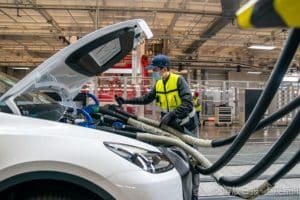- 🚗 Vay, a German startup, has launched a “driverless” service in the U.S.
- 🎮 The service utilizes “teledriving,” allowing remote operators to control the vehicles.
- 🏠 Vay’s cars are delivered without a driver, and users drive the vehicle to their destination.
- 🤖 Teledrivers can take over and park the car when the user is done with the trip.
- 🌐 Vay has performed tests with remote drivers on public roads in Europe and the U.S.
- 🚧 Regulatory hurdles are still being navigated in both European and U.S. markets.
- 🌍 Vay aims to provide convenient, affordable, and sustainable door-to-door mobility services.
- 💸 The pricing strategy is based on a “per-minute rental,” charging $0.30 per minute and $0.03 per minute for stopovers.
- 🚗 Unlike Tesla’s approach, Vay combines user-driven rides with the safety of real-world operators.
- 📈 Vay’s service is open to anyone within the UNLV and Arts District area in Las Vegas.
In a pivotal moment for the world of mobility, Vay, a German startup, has introduced its “driverless” service in the United States. However, the catch lies not in the absence of drivers but in the innovative approach of utilizing teledriving technology. Let’s delve into the intricacies of Vay’s groundbreaking service, exploring its features, challenges, and the potential it holds for the future of transportation.
Unveiling Vay’s “Driverless” Service
Vay, the German mobility disruptor, has made a bold entry into the U.S. market with its “driverless” service. Unlike conventional autonomous vehicles, Vay’s approach involves teledriving – a unique blend of user-driven rides and remote operators controlling the vehicles from a distance.
Teledriving Technology: A Closer Look
At the core of Vay’s innovation is teledriving, a technology that enables remote operators to take control of the vehicles. This distinctive approach allows users to hail cars without on-site drivers, making it a hybrid solution that merges user autonomy with the oversight of real-world operators.
The User Experience: From Delivery to Destination
Vay’s user experience begins with the delivery of a driverless car to the user, setting it apart from traditional ride-hailing services. Users then take the wheel, driving the vehicle to their desired destination. The journey doesn’t end there – when users complete their trip, they have the option to let a teledriver take over and park the car, eliminating the hassle of finding parking spaces.
Testing the Waters: Vay’s Road to Innovation
Vay’s journey to revolutionize mobility includes extensive testing on public roads in both Europe and the U.S. These tests, involving remote drivers, showcase the company’s commitment to ensuring the safety and reliability of its teledriving technology.
Navigating Regulatory Challenges
Despite the technological strides, Vay faces regulatory hurdles in both European and U.S. markets.The intricacies of navigating legal frameworks and safety standards underscore the complexities associated with introducing novel mobility solutions.
Vay’s Vision: Door-to-Door Mobility
Vay envisions providing convenient, affordable, and sustainable door-to-door mobility services. The integration of teledriving technology aligns with this vision, offering a unique solution that aims to free cities from the constraints of traditional parking-centric transportation.
Pricing Strategy: Per-Minute Rental Model
Vay’s pricing strategy introduces a “per-minute rental” model, where users are charged $0.30 per minute for driving and $0.03 per minute for stopovers. This flexible approach reflects Vay’s commitment to making its services accessible and cost-effective.
Contrasting Tesla’s Approach
In the landscape of autonomous driving, Vay’s approach differs from Tesla’s pursuit of a fully driverless ride-hailing platform. While Tesla aims for complete autonomy, Vay strategically combines user-driven rides with the oversight of teledrivers, addressing challenges associated with fully autonomous solutions.
Accessible Innovation: Vay’s Service in Las Vegas
Vay’s “driverless” service is not confined to a limited audience. The company has opened its doors to anyone within the UNLV and Arts District area in Las Vegas, marking a significant step toward making innovative mobility solutions accessible to a broader demographic.





